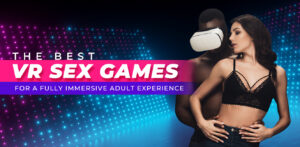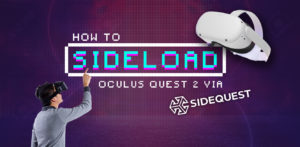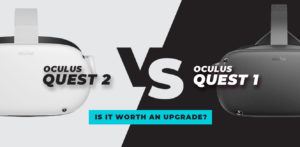As it develops, virtual reality (VR) technology promises to further blur the distinctions between the virtual and real worlds through its immersive experiences. The Apple Vision Pro is a revolutionary technology that uses eye tracking and hand pinching to control the user interface, and it represents one of the most important advances in VR interaction to date. The Vision Pro’s smooth and user-friendly interface has won over consumers and stoked anticipation for the potential of virtual reality communication.
![]()
Introducing the Creator of Apple Vision Pro’s Eye Tracking Interface, Supernova Technologies and the Nova UI Framework
Developers have begun looking for ways to replicate the Vision Pro’s eye-tracking-based interface on existing VR platforms as the VR community eagerly awaits its debut. Supernova Technologies, developers of the Nova UI framework for Unity, are making an effort along these lines. Supernova Technologies has produced a sideload able recreation of the Vision Pro’s interface using their knowledge and the capabilities of the Meta Quest Pro headset, giving users a taste of the possibility of eye-tracking interaction on the Quest Pro.
The Demo: App Grid and Gaze-Based Interaction
Supernova Technologies’ demo app uses the Quest Pro’s color passthrough functionality to put the app grid from Apple’s Vision Pro introductory movie in front of the user. Using the Quest Pro’s built-in eye-tracking technology, users may navigate the interface and choose desired options by looking at them. The Quest Pro’s controller-free hand tracking is also put to use in the demonstration, allowing “click” actions to be performed with pinching gestures.
Leveraging Eye Tracking and Hand Gestures on the Quest Pro
A proof-of-concept for the possibilities of eye-tracking interfaces on the Quest Pro, the demo’s app grid is merely for demonstration reasons and does not launch the apps. The video also highlights the sliders, toggle buttons, and resizing features of the Nova UI framework, which may be used for interactive design in virtual reality. Supernova Technologies has just created a sideload able reproduction of the Apple Vision Pro’s eye-tracking interface. Using the Quest Pro’s color passthrough, the demo app displays the app grid from the Vision Pro introduction film. The demo mimics Apple’s gaze and pinch-based interaction method by using the Quest Pro’s eye tracking for app selection and the controller-free hand tracking for pinching to “click.”
It should be noted that the demo serves only as a marketing tool and does not run the programs. However, it does demonstrate the potential of the Quest Pro’s eye-tracking interfaces and the possibilities of the Nova UI framework. The demo also features a demo panel with a variety of Nova UI interface components including sliders, toggle buttons, and scaling, so that users can experiment with the multiple ways in which they can interact with the demo.
Limitations of the Quest Pro’s Hand Tracking
Assuming correct calibration, the Quest Pro’s eye tracking operates admirably in this demonstration. In contrast to the Vision Pro, the Quest Pro’s controller-free hand tracking isn’t as robust. By employing cameras that point downwards, the Vision Pro enables users to pinch their fingers even while their hands are resting on a lower surface, such as a knee or a couch. In contrast, accurate hand tracking with the Quest Pro requires users to hold their hands in the air, which can be distracting and uncomfortable.
Downloading and Trying the Nova’s VisionOS Demo APK
You may grab a copy of Nova’s VisionOS sample APK from GitHub and sideload it onto your Quest Pro to give it a try. It should be noted that the Quest Pro is required for this demo to function, as the Quest 2 and Quest 3 do not support eye tracking.
User Fatigue and Strain in Eye-Tracking Interfaces
As demonstrated by the Quest Pro’s reproduction of the Apple Vision Pro, user fatigue and strain are a real possibility with eye-tracking interfaces. Eye-tracking is an alternative to conventional interaction methods like controllers or gestures, although it does demand the user’s undivided attention. Over time, the constant focusing and shifting of the eyes required to move around and select items in a virtual environment can contribute to eye strain and tiredness.
Keeping your eyes moving around the UI, especially when you’re browsing or reading the menus, might be tiring on your brain. Users may have to constantly process visual data, weigh options, and navigate the interface. This increased mental effort might lead to mental exhaustion, which in turn lessens convenience and pleasure.
Maintaining equilibrium between effective eye movement and rest intervals for the eyes is crucial in eye-tracking interfaces for reducing user fatigue and strain. Interfaces that lessen the need for the user to move their eyes across the screen and offer visual cues or feedback to direct their focus can assist in reducing mental effort and stress.
A user’s eyes can be rested and weariness prevented by including rest periods or breaks in the interface design at regular intervals.
The Potential of Neuroscience in Advancing Eye Tracking
Incorporating neuroscience ideas and techniques is an intriguing path toward improving eye-tracking interfaces like the Quest Pro’s reproduction of the Apple Vision Pro’s interface. Developers can better understand how the human brain interprets visual information and anticipates user actions by drawing on ideas from the study of neuroscience.
Research has demonstrated that eye behavior is affected by more than just the direction in which a person is looking; it can also be influenced by a person’s state of mind and expectations. Researchers have found, for instance, that users’ pupils dilate in anticipation of what would happen once they click on an object. Pupil dilation and other biometric data can help designers build more intuitive interfaces that can read a user’s mind and respond accordingly in real-time.
The “Mida’s touch” problem, in which undesirable objects are accidentally selected due to eye gaze, can be mitigated by the use of neuroscience-informed eye-tracking interfaces that filter out unnecessary eye movements. Furthermore, interfaces can anticipate user actions based on eye behavior patterns, decreasing lag and increasing the speed and accuracy of choices.
Additional study and collaboration between VR developers and neuroscientists is required to properly exploit the promise of neuroscience in developing eye tracking. By pooling knowledge from both areas, we can gain a deeper understanding of human visual perception and cognition, ultimately leading to more intuitive and natural eye-tracking interfaces.
Striving for Polished and Reliable Interfaces
![]()
The success of attempts to replicate the Apple Vision Pro’s eye-tracking interface on the Quest Pro depends on the quality and consistency of the interfaces developed for it. Users anticipate a constant and satisfying experience with no hiccups or surprises. To improve the interface’s efficiency, it is crucial to put resources into exhaustive testing, user input, and iterative design procedures.
Designers need to deal with input lag, precision, and gesture detection to create a clean and reliable interface. Maintaining a natural and immersive experience requires little latency between eye movements and interface responses. Similar improvements in the precision of eye tracking and hand gesture recognition technologies will help ensure error-free and trustworthy interaction.
To find trouble spots and learn about users’ experiences, usability testing and feedback are essential. Designers can learn more about consumers’ preferences, challenges, and expectations by including them early and often throughout the development process.
In the end, it takes a careful approach that takes into account the subtleties of human perception, interaction patterns, and user expectations to create a polished and reliable interface. Developers may work toward interfaces that provide seamless and pleasurable experiences on the Quest Pro and other VR platforms by combining rigorous testing, ongoing improvement, and a user-centric design philosophy.
The Future of Eye-Tracking Interfaces in VR
The Quest Pro, by recreating the Apple Vision Pro’s eye-tracking interface, hints at the potential of how virtual reality interactions might take place in the future. The use of eye-tracking interfaces has enormous potential to revolutionize our experience of virtual reality as technology advances.
The future of interface design is bright, with developments in eye-tracking technologies fueling continuous study in neuroscience and human-computer interaction. Increases in hardware precision and decreases in latency will result in a more satisfying experience for users and more natural, intuitive interactions when using eye-tracking technology.
More so, with the help of AI and machine learning algorithms, eye-tracking systems will be able to comprehend user intent and behavior, leading to more flexible and unique user experiences. Eye-tracking interfaces can dynamically alter their answers and enable customized interactions by assessing physiological data including pupil dilation, eye movement patterns, and user preferences.
In addition, when eye-tracking technology becomes more generally available and utilized, it will most certainly present novel opportunities for programmers of many kinds. Eye-tracking interfaces have the potential to transform several fields in the VR landscape, from gaze-based navigation in immersive gaming to gaze-enabled productivity applications and improved social interactions.
We should expect eye-tracking interfaces to become central to the VR experience in the future as the VR industry continues to innovate and push the boundaries of what is possible. Constant study, teamwork, and technological progress bring closer the possibility of smooth, intuitive, and immersive encounters.
Collaboration and Innovation in the VR Community
The VR community’s collaborative and creative spirit is on full display in the Quest Pro’s reproduction of the Apple Vision Pro’s eye-tracking interface. Developers, researchers, and fans are continually expanding the capabilities of virtual reality (VR) systems, discussing their findings, and helping to advance the field as a whole.
Developers encourage cooperation and information sharing by freely disseminating their work, as seen by Supernova Technologies with the Nova UI framework. This not only speeds up development but also inspires others to expand upon previous work and find new ways to interact with virtual reality.
The VR community’s thriving ecology is a testing ground for novel ideas and methods of improvement. Developers can share their work, ask for criticism, and gain insight from their peers via forums, conferences, and online communities. This sharing of resources and ideas is what drives progress in virtual reality and makes rapid iteration possible.
Collaborations between companies producing hardware and software as well as academic organizations are crucial to the advancement of new ideas. These partnerships allow for the production of innovative technologies and experiences by pooling knowledge and resources.
The VR community’s continued attempts to work together in this rapidly changing environment will determine the direction the industry takes. More interesting developments in VR interaction design, making immersive experiences more approachable, intuitive, and transformative for people globally, can be expected as individuals and organizations work together to share knowledge, exchange ideas, and push the frontiers of what is possible.
Bringing the Apple Vision Pro User Interface to the Quest Pro – Frequently Asked Questions
Can I use the Quest 2 or Quest 3 headset to achieve the same eye-tracking interface as the Apple Vision Pro?
Unfortunately (for you), the Apple Vision Pro can’t use the sideload able reconstruction of the UI created for the Quest Pro. The Quest 2 and Quest 3 headsets aren’t suitable for this kind of engagement because they lack eye-tracking capabilities.
Are the icons for the apps shown in the demo clickable? What about launching programs, can I do it with the game?
The app icons shown in the example are not clickable and will not open any apps on your device. The demo is meant to demonstrate the capabilities of the eye-tracking interaction system and the Nova UI framework for Unity.
How precise is the Quest Pro’s eye tracking in this simulation?
When calibrated properly, the Quest Pro’s eye tracking works well in the demo. It’s worth noting, though, that the Quest Pro’s eye tracking could not be as precise or quick as the Vision Pro’s.
Can I use additional hand movements besides pinching to control the simulation?
To simulate the “click” action, A4: Pinch gestures are used extensively throughout the demonstration. The demo is focused on pinch-based interaction, while other hand gestures may be possible depending on the implementation. It’s worth noting that the Quest Pro’s controller-free hand-tracking can’t compare to the Vision Pro’s specialized hand-tracking capabilities, so keep that in mind.
What about the Quest Pro’s eye-tracking interface; Will it get better with updates or new features?
We can anticipate enhancements in eye-tracking capabilities and general interaction design as technology and VR systems continue to develop. The Quest Pro’s eye-tracking interface is subject to possible future improvements as developers, academics, and manufacturers work tirelessly to improve user experiences across the board. As the virtual reality business continues to innovate and push the limits of what is possible, this is an interesting sector to watch.
Apple Vision Pro’s Eye Tracking Technology Summary
Developers and enthusiasts are always exploring new territory and reporting back to the community with their findings and insights. The virtual reality business has been propelled ahead by this culture of innovation and open sharing of information. The Quest Pro’s outstanding reproduction of the Apple Vision Pro’s eye-tracking interface exemplifies the ongoing difficulties and potentials of VR interaction design.
If developers, academics, and hardware makers can work together, eye-tracking interfaces have the potential to revolutionize how we interact with virtual environments. Thanks to these developments, we can anticipate a future in which eye-tracking interfaces completely reshape how we engage with virtual reality (VR) systems. Once again, the future of VR technology is looking bright.






